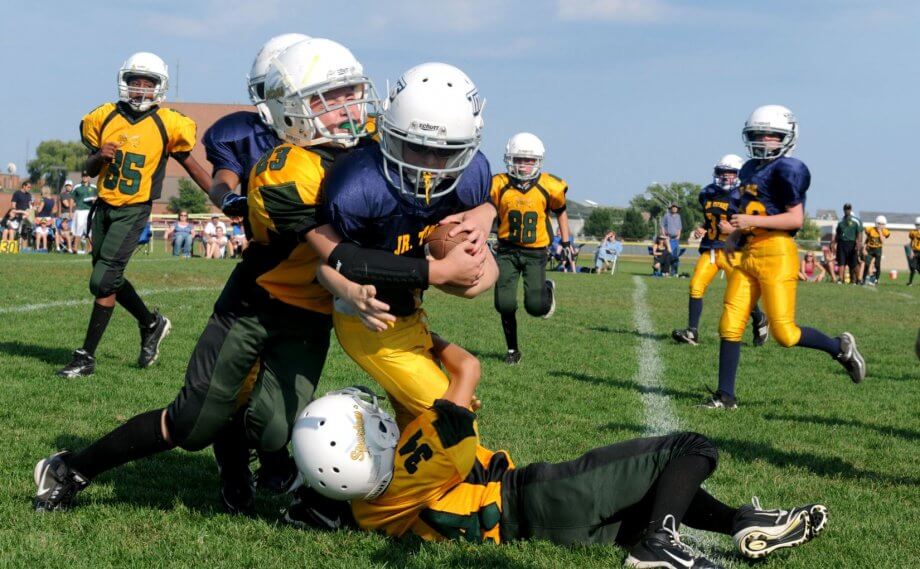Sports safety tips and equipment including mouthguards & sugar in sports drinks
As parents, we want our children to thrive. We guide and encourage healthy choices and activities, including exercise. Whether your kids have athletic prowess or are part of the support team, involvement with a sport is beneficial in many ways – building strength and muscle tone, interacting with others, stress release and more. But athletics are not all fun and games. Sports safety is crucial.
With very young children, parents are essentially in control, ensuring our kids’ safety and overseeing their choices. Once kids are in school, we’re still very involved, often packing their gear and serving as parent taxis for activities, practices and games. Sitting on the sidelines of lacrosse matches or in the stands at the ice rink, we can stack the deck in our kids’ favor, making sure their helmet, water bottle and mouthguard are easily accessible.
These are the years to educate, to help your child build responsible habits for sports safety. Some kids listen and learn; others need scare tactics like photos or stories about life after a head injury, root canals due to broken teeth and potential lasting health effects due to dehydration. Whatever it takes.
Once in middle school, many kids are inclined to shrug free of (possibly overbearing?) parental involvement and follow the lead of their peers. While we want to encourage our kids’ growth and foster their independence, we also know that those peers aren’t always making the best choices. And fitting in can prevail over personal safety and healthy choices.
Five important facts about sports health and safety
1. Thumbs-down for sugars and sweeteners
The global sports drink industry is gigantic and growing … expected to reach $5.92 billion by 2021 (Reuters).
While the main ingredient in sports drinks is water, they also contain carbohydrates, mostly in the form of sugars like glucose, sucrose and fructose. These sugars provide unnecessary calories, are bad for teeth and can offset the positive calorie-burning benefits of exercise. Furthermore, high carbohydrate beverages take longer to actually hydrate you. Running expert Coach Jeff of RunnersConnect notes that as a general rule, the higher the carbohydrate content of your beverage, the slower the absorption rate will be.
While low-calorie sports drinks have less sugar, they often contain artificial sweeteners and colors — both undesirable chemical additives.
2. Helicopter parents need not hover
In the greater majority of cases, simple common sense can help people to avoid dehydration. A player experiencing a cramp or pain needs to slow down and walk it off. Likewise, a player who is thirsty needs to drink. Dr. Francis Wang, the team physician for Harvard athletics, tells his athletes, “for most players, thirst is a good guide for hydration.” It’s as simple as that.
3. Most of us aren’t running marathons
Sports drinks include electrolytes (like sodium and potassium) and carbohydrates (sugars, including glucose, sucrose or fructose). Sports drinks “were originally developed for hard-core athletes to replenish electrolytes, such as sodium and potassium, that are lost in sweat, plus carbohydrates that muscles use for fuel,” notes Amy Keating, RD, a nutritionist for Consumer Reports. “The average exerciser needs to replace water, not electrolytes.”
WebMD agrees, stating “for most outdoor activities, good old-fashioned tap water does the trick.” Bonus: In most towns, tap water is enriched with fluoride, a mineral that is beneficial for your teeth.
Worth repeating: Water is the best method of hydration unless you’re an endurance athlete.
4. Teeth don’t grow back
Chances are one of your child’s teammates (or your own child) has suffered a sprained ankle, torn tendon or broken bone. And while any of those injuries may result in the end of a season or even a spot on the team, they generally heal in time or can be surgically repaired if necessary.
Teeth, on the other hand, don’t heal. The National Youth Sports Foundation for Safety reports that an athlete is 60 times more likely to sustain damage to the teeth when not wearing a protective mouthguard. Damage can include broken or chipped teeth as well as nerve damage to a tooth, which could necessitate a root canal.
The Cleveland Clinic recommends use of mouthguards not only in organized sports (where they may be mandated), but also in non-contact sports and recreational activities such as mountain biking. Cleveland Clinic sports and exercise medicine physician Anne Rex, DO, FAOASM advises parents to require that their children wear mouthguards from a young age and to consider the mouthguard an essential element of their gear.
5. Concussions are not child’s play
Where the possibility of brain injury is involved, there’s no such thing as excessive caution. Concussion protocols are prevalent today in sports at every level. Sports and exercise medicine physician Anne Rex notes that “mouthguards may also reduce the severity of concussion, helping to redistribute forces from a blow to the head, which in turn can reduce the severity of a concussion.”
Keep your kids and yourself healthy and safe with common sense practices about sports safety.
Questions about mouthguards? Don’t hesitate to ask. We’re here to help.

